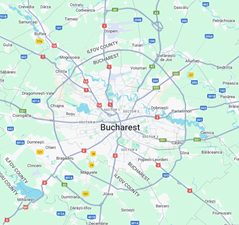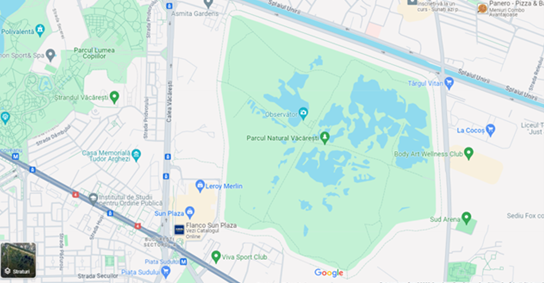DS#2 - Vacaresti Natural Park. Romania
This page is also available in Romanian ![]()

Location
Văcărești Nature Park in Romania (Nature Protected Area)
The demonstration site, Văcărești Nature Park (VNP), is located in the city of Bucharest, Romania. It concerns an urban area (biogeographical type: Continental) with an approximate area of 183ha.
 ,
, 
© Google Map

Description of the area
In a nutshell:
- First urban nature reserve in Romania (IUCN Category V)
- ’’Bottom-up project’’. It emerged as a community project supported and coordinated by the APNV/VNPA (Lead DS 2)
- > 5000 trees
- High biodiversity (200 bird species, >300 plants, 8 reptiles, 6 amphibians, 14 mammals)
The ‘Văcărești Nature Park’ (VNP) is a protected natural area in Bucharest, Romania, located 4 km from the city centre. Situated on the right bank of the Dâmbovița River, it spans 183 hectares, making it the largest green space in Bucharest and is sometimes referred to as the ‘Bucharest Delta’. The park developed naturally on the site of a former water reservoir, initially designed and then abandoned by the former Romanian Communist regime in 1989. Following a national civic campaign in 2016, the area was officially designated as a nature park (IUCN category V, http://ananp.gov.ro/ariile-naturale-protejate-ale-romaniei/), becoming Romania's first urban nature park.
The Dâmbovița River, which originates in the Făgăraș Mountains, flows through Bucharest from the west to the southeastern part, serving as a tributary to the Argeș River after a course of 258 km. In Bucharest, it borders the VNP for over a kilometre but is no longer naturally connected to the reserve.
The ‘Văcărești Nature Park’ (VNP) is a rich wetland, home to over 300 species of vascular plants and more than 200 species of birds, including herons, egrets, cormorants, mallards, coots, swans, whiskered terns, and marsh harriers. The lakes and surrounding areas support 10 species of fish, 6 species of amphibians, and 6 species of reptiles. Several of these species, such as the great crested newt, the fire-bellied toad, and the European pond turtle, are protected under the EU Habitats Directive. Small mammals, including otters, foxes, and weasels, also inhabit this urban wetland.
![]()
![]()
© Vacaresti Nature Park Association

Climatic Challenges
The Văcărești Natural Park is currently affected by changes in precipitation patterns and an increase in annual temperatures, leading to a rapid alternation of droughts and flash floods. Over the last five years, there has been a considerable diminution, clogging, and drying of wetlands and small lakes in the park. These issues are leading to biodiversity loss in the park and compound heatwaves in the urban area. The recent heatwaves in spring 2022 also led to another unwanted effect of climate change in VNP, Bucharest: fires in dried vegetation areas. The combined effects also lead to a decrease in the quality of life of the citizens in the City of Bucharest.

Planned activities
The first objective in the Văcărești Nature Park is to restore a network of temporary ponds, inside the park, using the rainwater collected on the park’s dike. The water will be maintained in special designed raingardens – habitats for amphibians and specific flora. The intervention will help restore the temporary ponds lost in the past years, and will contribute to the conservation of endangered species.
The second objective is to collect the rainwater outside the park for the wetland restoration and conservation. The possible intervention is the restoration of the park’s ponds using the rainwater collected on the shopping mall`s roof. The rainwater will be collected, maintained, biofiltered and pumped inside the park.
The activities to be implemented are:
- Seasonal rainwater collection and storage (inside and outside the national park);
- Bio-filtration;
- Designing and building a network of temporary ponds
- Restoring wetland zones of VNP lost in the last years due to aridization;
- Developing a strategy for connecting the VNP to the green blue infrastructure of the city (interconnected activities within FL#2 (Children’s World Park-CWP);
- Consistent actions and innovative social engagement together with regional communities and selected stakeholders in order to improve knowledge on the NBSs and responsibility for the environment activities;
- Development of stakeholders within the project

Ambition
Ambition during the project
The ambitions during the project are the following:
- Cooperation and knowledge sharing within the project team for design, implementation and impact monitoring of the NBSs,
- Enhance community awareness and knowledge base for NBS application and engagement of stakeholders in the process, for sustainability of the results on long term,
- Validate the results and establish a monitoring scheme and adaptive management plan to assess the efficiency of the NBS implemented,
- Create a solid, evidence-based reference for upscaling the results in regional, national and other Eastern European contexts.
Ambition after the project
The following lasting impacts are foreseen:
- The pilot NBS will help establishing the base for the blue-green Bucharest path, supporting biodiversity,
- By innovative rainwater management, the pilot NBS will improve the water resilience, including quality of water in the VNP,
- The NATALIE NBS should reduce the urban heat in that area, contributing to the cooling effects during increasing summer heatwaves,
- The NBSs in VNP provide educational opportunities for schools, community groups, and the public to learn about ecology, environmental sustainability, and the importance of biodiversity within their area (including community long term engagement),
- Well designed and implemented NBSs will demonstrate cost-effective solutions for urban challenges, such as rain/stormwater management, and climate change adaptation, potentially contributing not only to improved wellbeing but also to cost savings on long-term (health, avoided damages due to extreme events, etc.).

Involved partners
 |
 |
